Introduction
France boasts a rich historical heritage that spans millennia, making it a captivating destination for history enthusiasts worldwide. From the prehistoric cave paintings of Lascaux to the grandeur of the Palace of Versailles, the country’s history is marked by a tapestry of events, art, and architecture. France’s ancient roots are evident in sites like the Roman arenas of Arles and the medieval city of Carcassonne, showcasing its evolution through various civilizations. The Renaissance left an indelible mark on France, influencing iconic landmarks such as the Château de Chambord and the Loire Valley’s splendid castles.
Historical tourism in France is of paramount importance, not only for preserving its rich cultural legacy but also for economic vitality. The country’s historical sites, from ancient Roman ruins to World War II memorials, attract millions of tourists annually. These visitors contribute significantly to the economy through spending on accommodations, dining, and cultural experiences. Furthermore, historical tourism helps educate locals and visitors about France’s past, fostering a deeper appreciation for its cultural identity. Preservation efforts ensure that future generations can continue to learn from and enjoy these invaluable historical treasures.
Paris: The Heart of French History
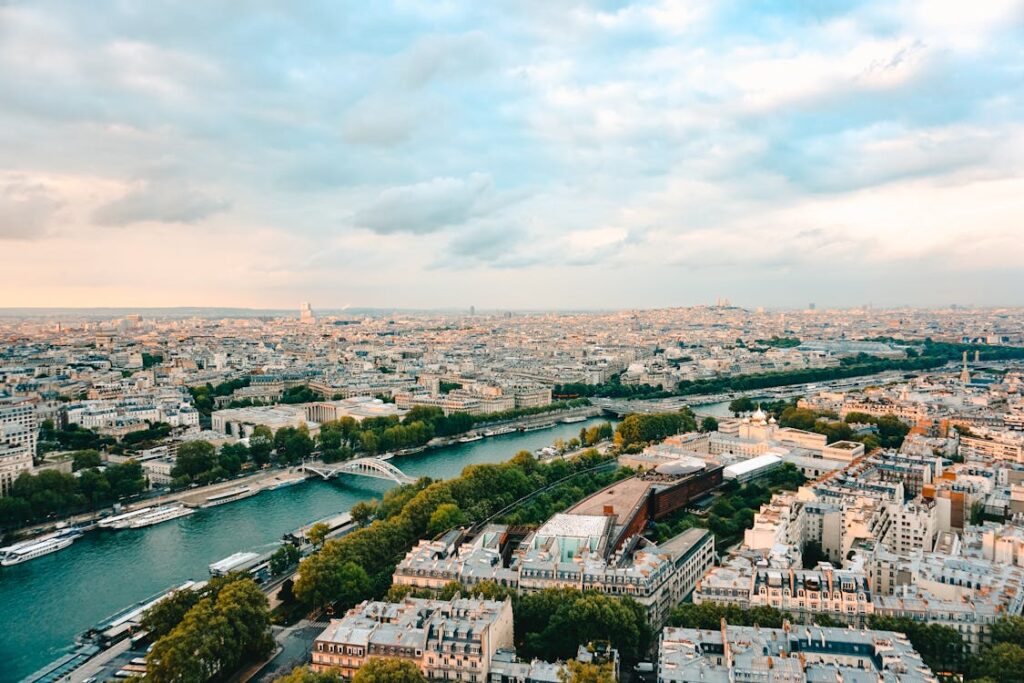
Paris represents the heart of French history, embodying centuries of cultural, political, and artistic evolution. As the capital city, Paris has been a center of power since medieval times, witnessed through landmarks like the Notre Dame Cathedral and the Louvre Palace, which later became the renowned Louvre Museum. The French Revolution of 1789, a turning point in global history, unfolded on the streets of Paris, marking the end of the monarchy and the birth of modern democracy. In the 19th century, Paris became a beacon of intellectual and artistic creativity, epitomized by the Eiffel Tower, a symbol of French innovation and engineering. Today, Paris continues to attract millions of visitors who come to explore its rich history, from the Palace of Versailles’s grandeur to Montmartre’s bohemian ambiance, ensuring its legacy remains vibrant and enduring.
Eiffel Tower
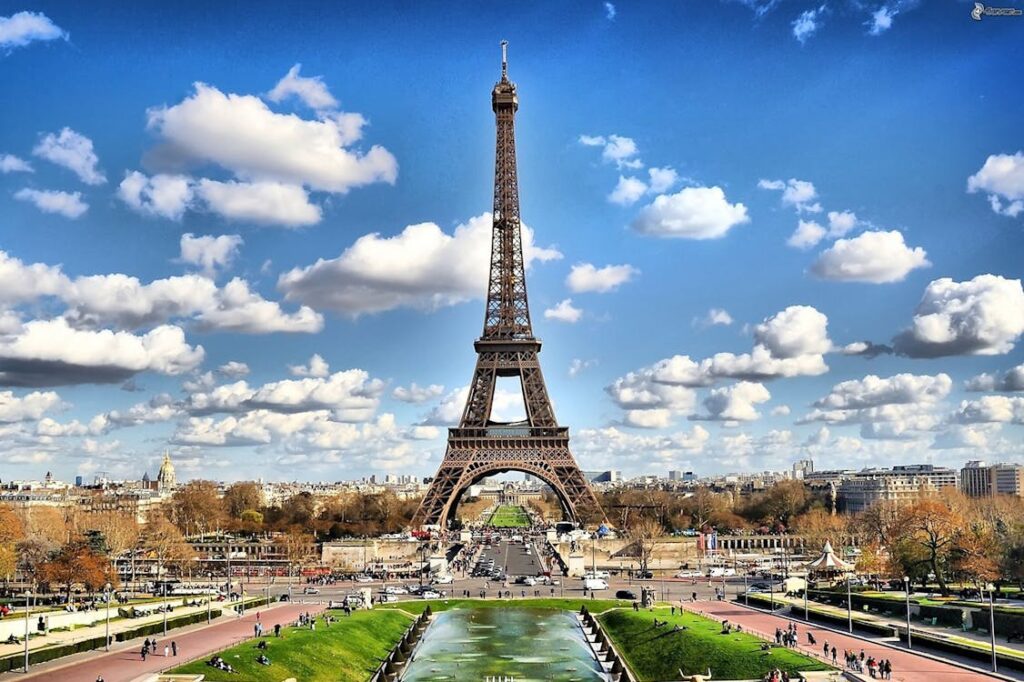
The Eiffel Tower, an iconic symbol of Paris and France itself, stands as one of the most recognizable landmarks in the world. Completed in 1889 for the Exposition Universelle (World’s Fair), it was initially met with mixed reactions but has since become a beloved symbol of French culture and engineering prowess. Designed by Gustave Eiffel, the tower rises 324 meters (1,063 feet) high and was the tallest artificial structure in the world until 1930. Its wrought iron lattice structure and graceful design make it an architectural marvel and a testament to the Industrial Age and the Belle Époque era in Paris.
Historical significance
Historically, the Eiffel Tower has played significant roles beyond its architectural and engineering achievements. During World War I, it served as a crucial radio transmission tower, intercepting enemy communications and contributing to Allied intelligence efforts. It has also been a backdrop for countless historic events, illuminated in the French national colors during critical moments in French history. Today, it remains a powerful symbol of France’s cultural and historical heritage, attracting millions of visitors annually.
Guided tours and observation points
Visitors to the Eiffel Tower can enjoy a variety of guided tours and observation points that offer stunning views of Paris. Guided tours provide insights into the tower’s history, construction, and cultural significance, offering visitors a deeper understanding of its place in French history. The tower has multiple levels accessible by elevators or stairs, each offering unique city perspectives. The top observation deck, at 276 meters (906 feet), provides panoramic views that stretch for miles, offering visitors a chance to see landmarks like the Arc de Triomphe, Notre Dame Cathedral, and the Seine River from a breathtaking vantage point. Whether by day or night, the views from the Eiffel Tower are unforgettable, making it a must-visit destination for anyone exploring Paris.
Louvre Museum
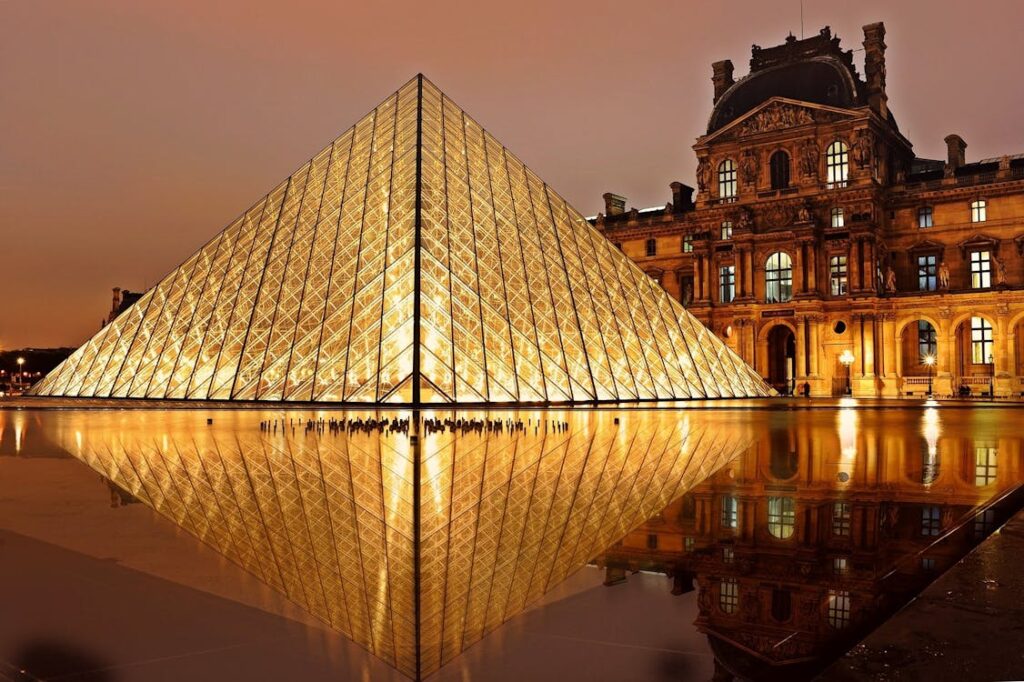
The Louvre Museum, located in the heart of Paris, is one of the world’s largest and most visited museums, renowned for its extensive art and artifact collections. Originally a royal palace, the Louvre’s history dates back to the late 12th century, when it was built as a fortress by King Philip II. Over the centuries, it evolved from a medieval fortress to a Renaissance palace and, finally, to the grand museum we know today. Its iconic glass pyramid entrance, designed by architect I.M. Pei and completed in 1989, symbolizes modern Parisian architecture.
History of the building and its collections
The Louvre Museum houses an impressive collection spanning thousands of years and representing diverse civilizations. Its collections include ancient Egyptian artifacts, Greek and Roman sculptures, European paintings from the medieval to the 19th century, and Islamic art. The museum’s most famous painting, Leonardo da Vinci’s “Mona Lisa,” draws millions of visitors annually, along with other masterpieces such as the ancient Greek statue of “Venus de Milo” and Eugène Delacroix’s “Liberty Leading the People.”
Notable exhibits and guided tours
Guided tours of the Louvre Museum offer visitors a deeper understanding of its vast collections and rich history. These tours cover thematic routes, focusing on specific collections or highlights such as Italian Renaissance art, French paintings, or ancient civilizations. Expert guides provide insights into the history, significance, and context of the museum’s exhibits, making the visit informative and enriching. Additionally, the museum offers special exhibitions that rotate periodically, showcasing specific artists, themes, or periods in art history. Whether exploring on a guided tour or independently, the Louvre Museum offers a profound journey through art and history, captivating visitors with its unparalleled treasures.
Notre-Dame Cathedral
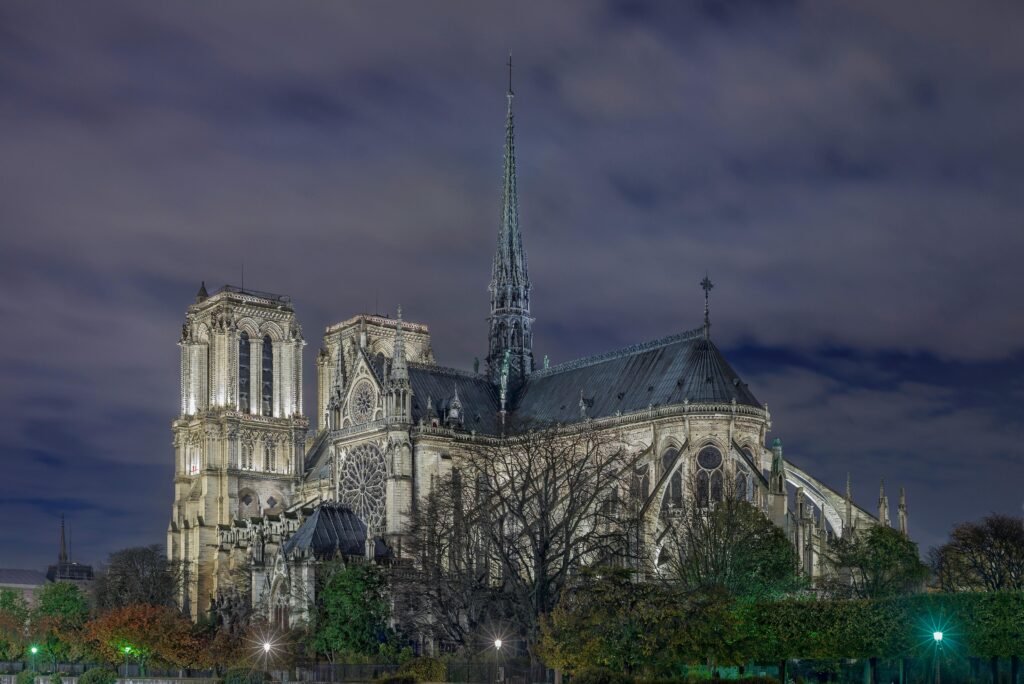
Notre-Dame Cathedral, located on the Île de la Cité in Paris, is a masterpiece of French Gothic architecture and one of the most iconic cathedrals in the world. Construction began in 1163 during the reign of Louis VII, and in 1345, it was completed. The cathedral is renowned for its intricate facades, stunning stained glass windows, and impressive flying buttresses that support its structure. The famous rose windows, notably the North Rose Window, are some of the finest examples of medieval stained glass craftsmanship. Notre-Dame’s twin towers, standing at around 69 meters (226 feet) high, offer panoramic views of Paris and are accessible to visitors.
Architectural history
Architecturally, Notre Dame Cathedral represents the pinnacle of the French Gothic style. It was built on the site of earlier churches, including a Romanesque basilica, and its construction spanned several centuries, reflecting the evolution of Gothic architecture. The cathedral’s interior is equally impressive, featuring a nave that stretches over 130 meters (426 feet) long and a choir adorned with beautifully carved stalls and sculptures. The west facade is dominated by three portals decorated with statues and relief carvings depicting biblical scenes and saints.
Tours and visits
Tours and visits to Notre Dame Cathedral allow visitors to explore its rich history and architectural splendor. Guided tours provide insights into the cathedral’s construction, history, and religious significance. Visitors can admire the impressive interior, including the stunning rose windows and the magnificent organ. The crypt beneath the cathedral houses archaeological remains dating back to Roman times, offering a glimpse into Paris’s early history. While access to certain areas, such as the roof and spire, may be limited due to ongoing restoration efforts following the 2019 fire, Notre Dame remains a symbol of resilience and inspires awe and reverence.
Versailles: The Grandeur of the French Monarchy
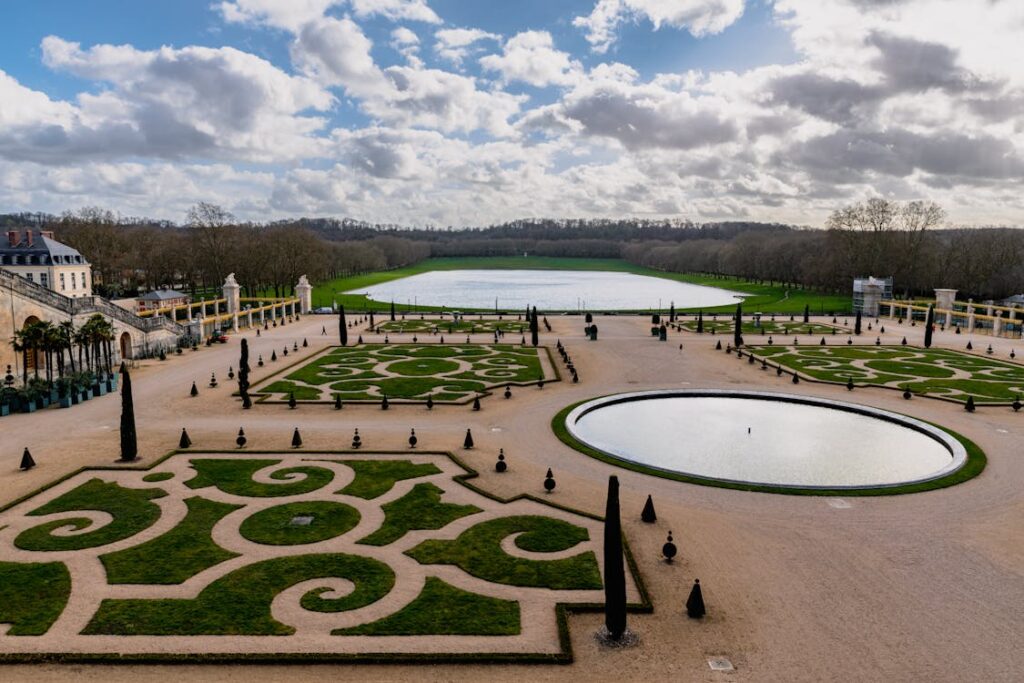
Versailles, the opulent palace located just outside of Paris, epitomizes the grandeur and extravagance of the French monarchy. Originally a hunting lodge for Louis XIII, it was transformed and expanded by his son, Louis XIV, into a magnificent symbol of absolute power and royal splendor. The Palace of Versailles is renowned for its lavish architecture, elaborate gardens, and the Hall of Mirrors, a dazzling gallery where the Treaty of Versailles was signed in 1919. The grandeur of Versailles reflects the artistic and cultural zenith of the French Baroque period, showcasing the monarchy’s wealth and influence. Today, Versailles stands as a UNESCO World Heritage site, attracting millions of visitors who marvel at its historical significance and breathtaking beauty.
Palace of Versailles
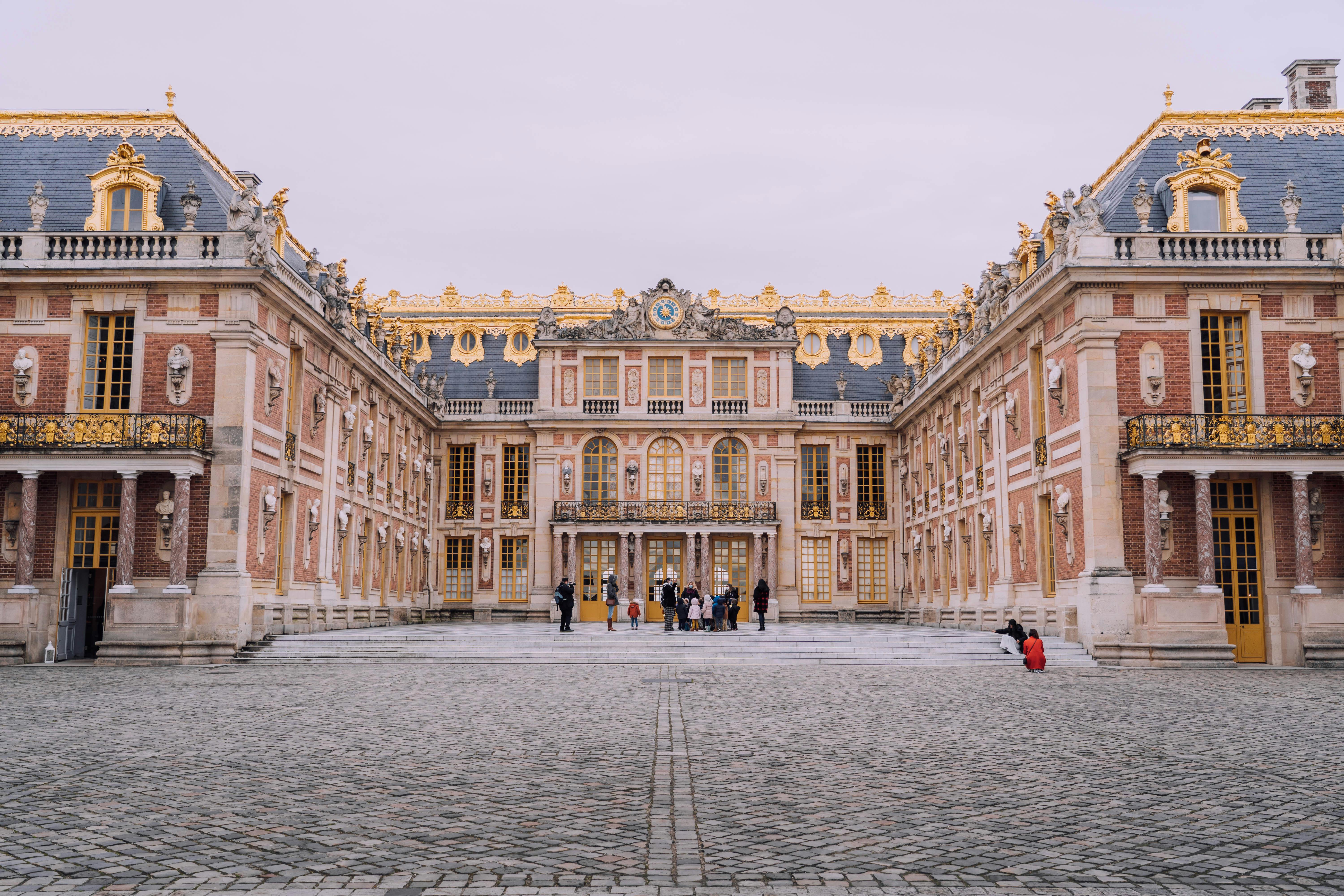
The Palace of Versailles, located about 20 kilometers southwest of Paris, is one of the world’s most extravagant and historically significant palaces. Originally a modest hunting lodge for Louis XIII, it was transformed by his son, Louis XIV, into a glorious symbol of royal power and artistic achievement. The palace complex spans over 800 hectares and includes the main palace, meticulously manicured gardens, the Grand Trianon, and the Petit Trianon. The opulence of Versailles is evident in its elaborate interiors, gilded decorations, and the iconic Hall of Mirrors, which reflects the palace’s luxurious style and the absolute monarchy’s grandeur.
History of the palace and its significance
The history of the Palace of Versailles is deeply intertwined with the history of France and its monarchy. Under Louis XIV, known as the Sun King, Versailles became France’s political power center from 1682 until the French Revolution in 1789. The palace was designed to awe and intimidate, showcasing the king’s absolute power and the splendor of the French state. The Hall of Mirrors witnessed significant historical events, including the proclamation of the German Empire in 1871 and the signing of the Treaty of Versailles in 1919, which ended World War I. Versailles symbolizes the zenith of the French Baroque style and the absolute monarchy’s influence on European history.
Touring the palace and gardens
Touring the Palace of Versailles offers visitors a glimpse into the French monarchy’s lavish lifestyle and the period’s architectural magnificence. Guided tours provide detailed insights into the palace’s history, its role in French political life, and the artistic achievements embodied in its design. Visitors can explore the State Apartments, the King’s and Queen’s chambers, and the opulent Hall of Mirrors. The expansive gardens, designed by André Le Nôtre, feature geometric patterns, fountains, and sculptures, offering a serene and picturesque complement to the palace’s grandeur. The Trianon Palaces and Marie Antoinette’s estate provide further historical context and a more intimate look at royal life. Whether strolling through the ornate halls or wandering the vast gardens, visiting Versailles is an immersive journey into France’s regal past.
The Hall of Mirrors
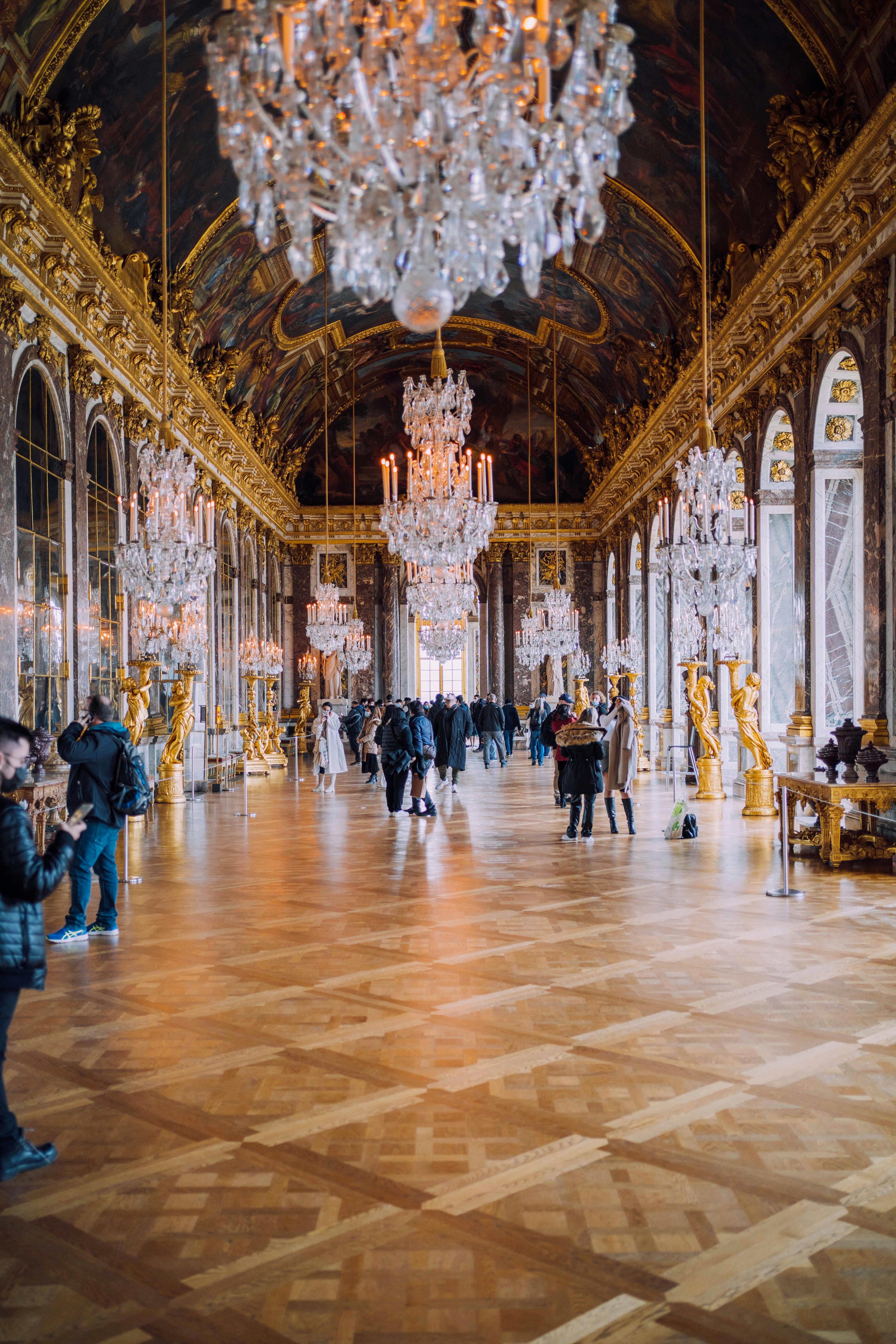
The Hall of Mirrors (Galerie des Glaces) is the most famous room in the Palace of Versailles and one of the most spectacular examples of Baroque architecture. This exquisite gallery stretches over 73 meters (240 feet) and features 17 large arched windows facing the palace gardens, each adorned with 21 mirrors, creating an astounding visual effect of endless reflection. The hall’s ceiling is elaborately painted with scenes glorifying the reign of Louis XIV, celebrating his military victories and accomplishments. The sparkling chandeliers and gilded sculptures enhance the luxury, making the Hall of Mirrors a breathtaking French art and design masterpiece.
Importance in French History
The Hall of Mirrors is the setting for many pivotal events in French and world history. It was in this grand hall that the Treaty of Versailles was signed on June 28, 1919, marking the end of World War I and reshaping the political landscape of Europe. The room was also used for royal ceremonies, including the reception of foreign ambassadors and grand state occasions during the reign of Louis XIV. The Hall of Mirrors symbolizes the power and prestige of the French monarchy and remains a testament to the nation’s rich cultural and historical heritage.
What to See During a Visit
Mirrored Arches and Windows: Admire the 357 mirrors that line the 17 arches opposite the windows, creating a stunning play of light and reflection.
Ceiling Frescoes: Look up to appreciate the detailed ceiling paintings by Charles Le Brun, depicting significant events from Louis XIV’s reign.
Gilded Sculptures: Examine the intricate gilded bronze sculptures that adorn the hall, including the candelabras and statues.
Chandeliers: Marvel at the crystal chandeliers illuminating the hall, adding to its majestic ambiance.
Historical Significance: Reflect on the hall’s role in major historical events, especially the signing of the Treaty of Versailles.
View of the Gardens: Enjoy the view of the meticulously maintained gardens of Versailles through the large windows, offering a picturesque backdrop to the hall’s interior splendor.
Here you can read more about the Historical Tours in Paris
Normandy: World War II and Beyond
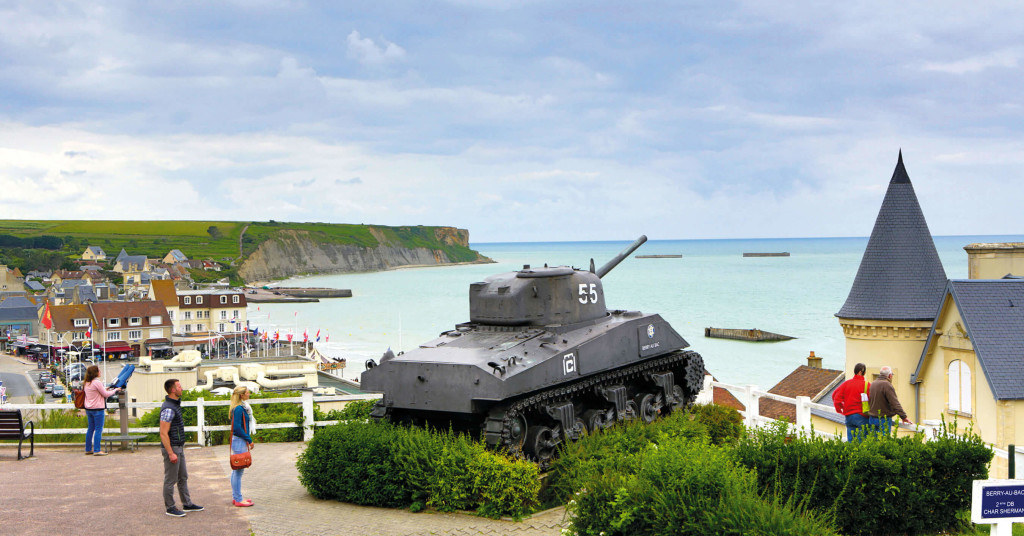
Normandy, a picturesque region in northern France, is etched in history as the site of the pivotal D-Day landings during World War II. On June 6, 1944, Allied forces launched Operation Overlord, the largest seaborne invasion in history, storming the beaches of Normandy to begin the liberation of Western Europe from Nazi occupation. The region’s beaches, such as Omaha and Utah, are now solemn memorials marked by museums, monuments, and cemeteries that honor the bravery and sacrifice of the soldiers. Beyond its wartime legacy, Normandy is renowned for its scenic beauty, charming towns, and cultural heritage, featuring landmarks like the medieval Mont Saint-Michel and the historic Bayeux Tapestry. Today, Normandy attracts visitors who pay homage to its historical significance and enjoy its natural and cultural treasures.
D-Day Beaches
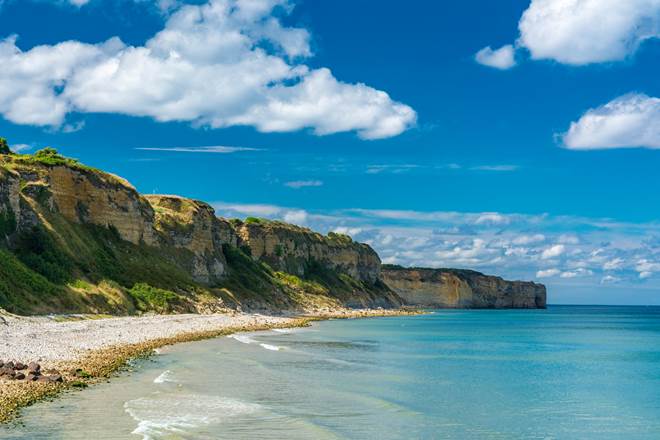
The D-Day beaches of Normandy are among the most hallowed grounds in modern history, marking the locations where Allied forces launched their audacious assault on Nazi-occupied Europe on June 6, 1944. The five main beaches—Utah, Omaha, Gold, Juno, and Sword—each played a crucial role in Operation Overlord, with American, British, and Canadian troops facing intense German fortifications. Omaha Beach, in particular, witnessed some of the heaviest fighting and highest casualties, earning it the somber nickname “Bloody Omaha.” These beaches are serene coastal stretches today, but their sands still resonate with the echoes of the bravery and sacrifice shown during that pivotal day.
Historical Context and Significance
The D-Day landings were a decisive turning point in World War II, marking the beginning of the end for Nazi Germany. The success of Operation Overlord enabled the Allies to establish a foothold in Western Europe, leading to the liberation of France and ultimately contributing to the defeat of the Axis powers. The planning and execution of D-Day involved immense logistical efforts, coordination among Allied nations, and immense bravery from the troops who stormed the heavily fortified beaches under relentless enemy fire. The significance of the D-Day landings extends beyond military strategy; it symbolizes the collective effort and sacrifice of the Allied nations to restore peace and freedom in Europe.
Guided Tours and Memorial Sites
Visitors to Normandy can explore the D-Day beaches and surrounding areas through various guided tours that provide a deep and moving insight into the events of June 6, 1944. These tours often include stops at key sites such as the American Cemetery at Colleville-sur-Mer, overlooking Omaha Beach, where thousands of white crosses and Stars of David mark the graves of fallen soldiers. The Pointe du Hoc Ranger Monument, a cliffside battlefield where U.S. Rangers scaled sheer cliffs to neutralize German artillery, is another poignant site. The Normandy American Museum and the Juno Beach Centre offer detailed exhibits on the landings and the broader context of the war. Guided tours bring history to life, offering narratives from expert guides, personal stories of soldiers, and a comprehensive understanding of the strategic and human dimensions of the D-Day landings.
Mont Saint-Michel
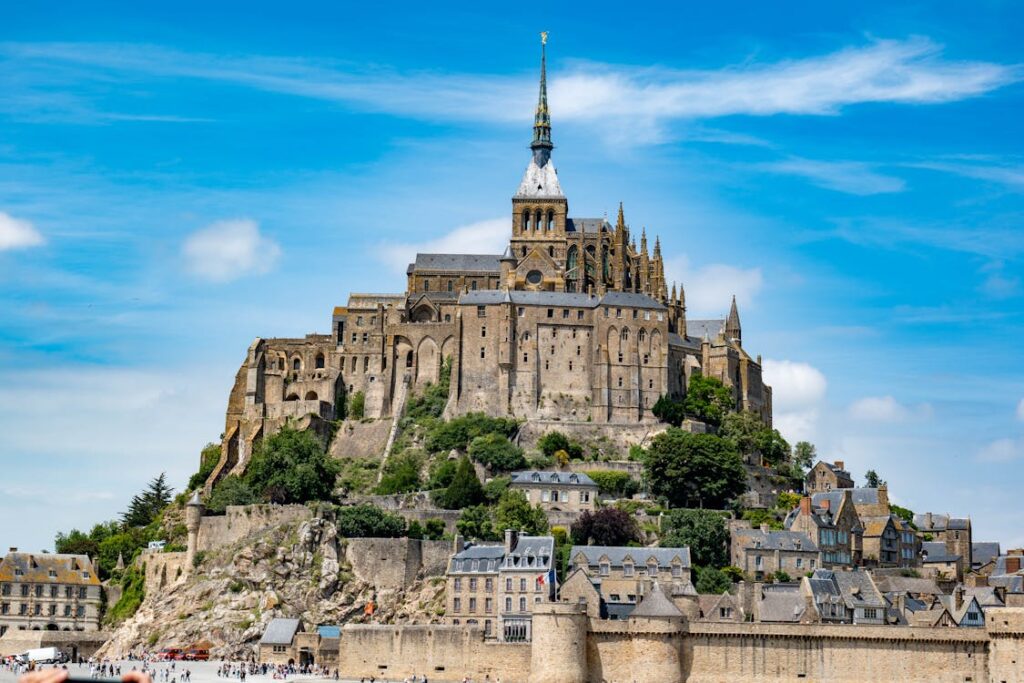
Mont Saint-Michel is a stunning tidal island and mainland commune in Normandy, France. Rising dramatically from the waters of the Couesnon River estuary, the island is crowned by a medieval abbey dedicated to Saint Michael the Archangel. Known for its mesmerizing beauty and strategic fortifications, Mont Saint-Michel has been a pilgrimage site for centuries. Its unique blend of natural and architectural splendor continues to captivate visitors. The island’s steep, narrow streets are lined with quaint shops, restaurants, and historic buildings, leading up to the awe-inspiring abbey at its peak.
History of the Abbey and Its Significance
The history of Mont Saint-Michel dates back to the early 8th century when, according to legend, the Archangel Michael appeared to the Bishop of Avranches and instructed him to build a church on the rocky island. The first monastic establishment was founded in 966 by Benedictine monks, and over the centuries, the abbey evolved into a remarkable example of medieval religious architecture. Due to its strategic location and natural fortifications, Mont Saint-Michel served as a critical defensive stronghold during various conflicts, including the Hundred Years’ War. Its significance extends beyond its military and architectural achievements, as it remains an important symbol of faith and perseverance, attracting pilgrims and tourists alike.
Visiting Tips and Tours
When visiting Mont Saint-Michel, planning is essential to make the most of the experience. The island is subject to dramatic tidal changes, so checking the tide schedule is crucial; during high tide, the causeway connecting the island to the mainland is submerged, while low tide allows for access by foot or shuttle. Visitors should wear comfortable shoes to navigate the steep, cobbled streets and stairways. Guided abbey tours are recommended highly, as they provide rich historical context and access to areas that may be overlooked. Highlights include the Gothic abbey church, the cloisters, and the refectory. For an enhanced experience, consider visiting early in the morning or late in the afternoon to avoid the peak tourist crowds and enjoy the serene beauty of this iconic site.
Here you can read post on Historical Tours in Normandy
Bordeaux: Wine and History
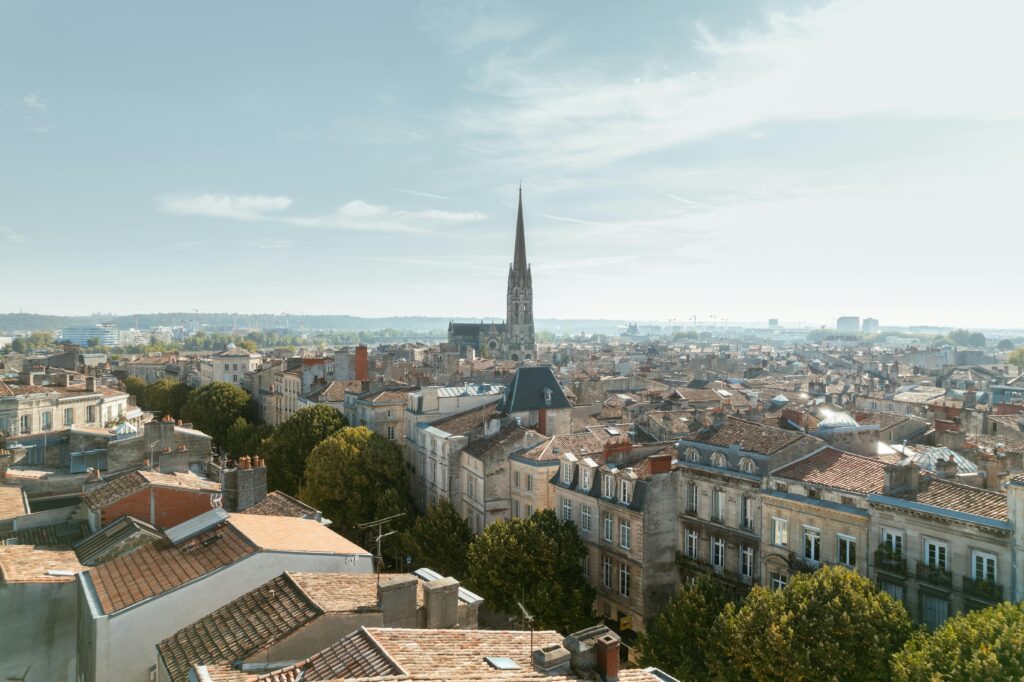
In southwestern France, Bordeaux is renowned worldwide for its exceptional wine and rich history. The region’s winemaking tradition dates back to Roman times, and it is now home to some of the most prestigious vineyards and châteaux, producing a wide variety of esteemed wines, including the famous Bordeaux blends of Cabernet Sauvignon and Merlot. The city’s historic center, a UNESCO World Heritage site, boasts stunning 18th-century architecture, reflecting its prosperous past as a major port and trade hub. Visitors can explore the elegant Place de la Bourse, the Gothic Saint-André Cathedral, and the vibrant quays along the Garonne River, all while enjoying the culinary delights and world-class wines that make Bordeaux a quintessential destination for lovers of history and viticulture.
Bordeaux Wine Region
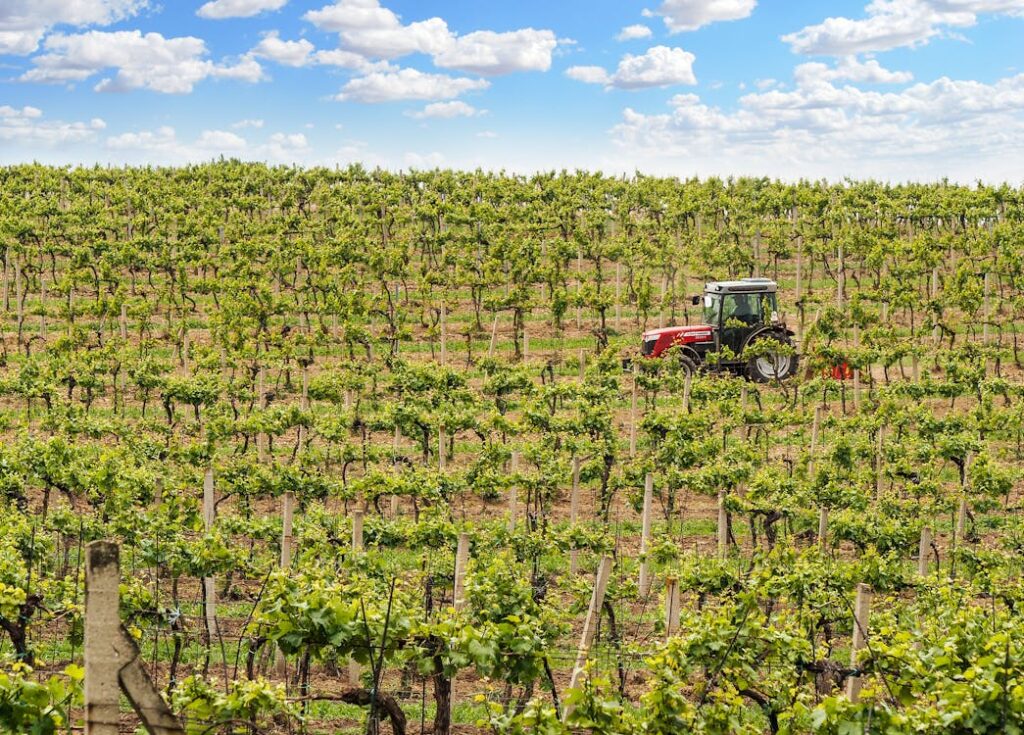
The Bordeaux wine region, located in southwestern France, is one of the world’s most famous and prestigious wine-growing areas. The region is divided into several sub-regions, each known for its unique terroir and grape varieties, including Médoc, Saint-Émilion, Pomerol, and Graves. Bordeaux is renowned for its red wines, predominantly blends of Cabernet Sauvignon, Merlot, and Cabernet Franc, and its exceptional white wines made from Sauvignon Blanc, Sémillon, and Muscadelle. The diverse microclimates and soil compositions across the region contribute to the distinct characteristics of Bordeaux wines, which range from robust and tannic to smooth and aromatic.
Historical Context of Wine Production
The history of wine production in Bordeaux dates back to the Roman era when vineyards were first established in the region, and the 12th century marked a significant turning point when the marriage of Eleanor of Aquitaine to Henry II of England expanded Bordeaux’s wine trade to the British Isles. This period saw a surge in demand for Bordeaux wines, solidifying the region’s reputation for high-quality viticulture. Over the centuries, Bordeaux’s wine industry continued to flourish, with significant developments such as establishing wine classification systems in 1855, which categorized the region’s best wines based on their quality and market value. Today, Bordeaux remains a global benchmark for excellence in winemaking, celebrated for its rich heritage and continuous innovation.
Wine Tours and Tastings
Wine tours and tastings in Bordeaux offer an immersive experience of the world of fine wine, allowing visitors to explore renowned vineyards and historic châteaux. Guided tours often include visits to prestigious estates such as Château Margaux, Château Lafite Rothschild, and Château Latour, where guests can learn about the winemaking process, from vine cultivation to barrel aging. Tastings typically feature a selection of the estate’s finest wines, allowing visitors to appreciate the nuanced flavors and aromas that define Bordeaux’s wine heritage. Many tours include educational components, such as wine-pairing workshops and blending sessions. Whether touring the grand estates of Médoc or the charming cellars of Saint-Émilion, these experiences offer a deep appreciation of the craftsmanship and tradition that make Bordeaux wines world-renowned.
Place de la Bourse
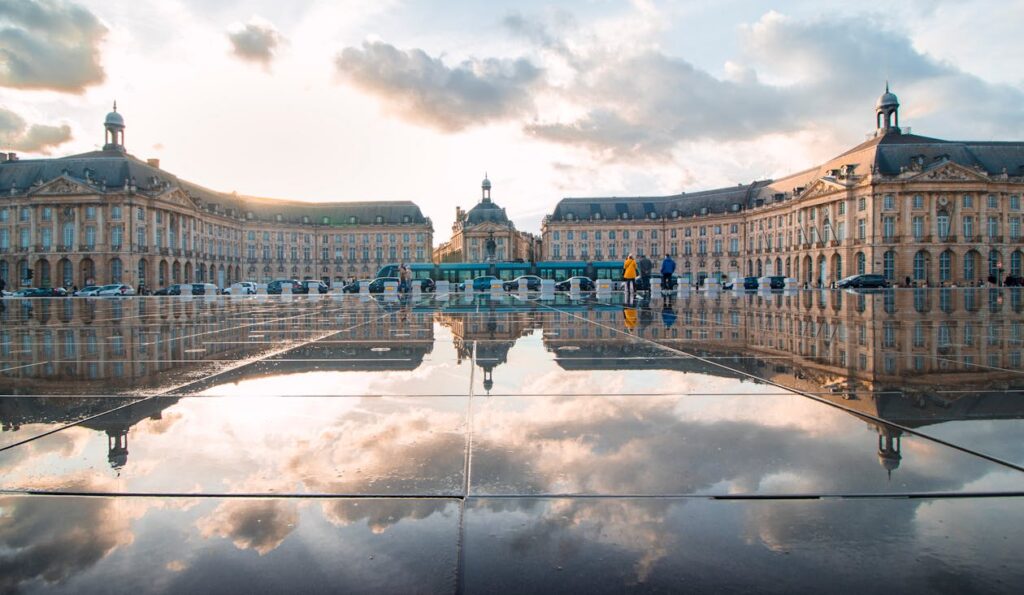
Place de la Bourse, along the Garonne River in Bordeaux, is one of the city’s most iconic and elegant squares. Designed by architect Ange-Jacques Gabriel in the 18th century, it epitomizes the grandeur of Bordeaux’s classical architecture. The square was initially intended to highlight the city’s prosperity and its status as a central trading hub. Dominated by the imposing Palais de la Bourse, which once housed the Bordeaux Stock Exchange, the square also features the Fountain of the Three Graces, symbolizing the city’s artistic and cultural heritage. The square’s harmonious design and stunning reflection on the adjacent Miroir d’Eau (Water Mirror) make it a must-visit site for tourists and locals alike.
Historical Architecture
The architectural significance of Place de la Bourse lies in its embodiment of the French Classical style, characterized by symmetry, proportion, and the use of classical elements such as columns and pediments. The buildings surrounding the square were constructed with limestone, giving them a luminous quality that changes with the light throughout the day. The Palais de la Bourse, with its grand facades and ornate detailing, showcases the architectural prowess of the 18th century. The square’s layout and design were part of an urban planning initiative to modernize Bordeaux and reflect its economic power and cultural sophistication. This period of architectural development significantly influenced the city’s aesthetic, contributing to Bordeaux’s designation as a UNESCO World Heritage site.
Walking Tours and Landmarks
Walking tours of Place de la Bourse and its surrounding landmarks offer a captivating journey through Bordeaux’s rich history and architectural splendor. Visitors can start at the square itself, taking in the stunning reflections on the Miroir d’Eau, the largest reflecting pool in the world. From there, a stroll along the Garonne River leads to the nearby Pont de Pierre, an impressive stone bridge commissioned by Napoleon Bonaparte. Walking tours often include insights into the architectural details of the Palais de la Bourse and the history behind the Fountain of the Three Graces. Additionally, guided tours may extend to nearby attractions, such as the Grand Théâtre de Bordeaux, another masterpiece of classical architecture. These tours provide a comprehensive understanding of Bordeaux’s urban development, cultural significance, and the architectural marvels that define the city’s historic core.
Provence: Roman Ruins and Lavender Fields
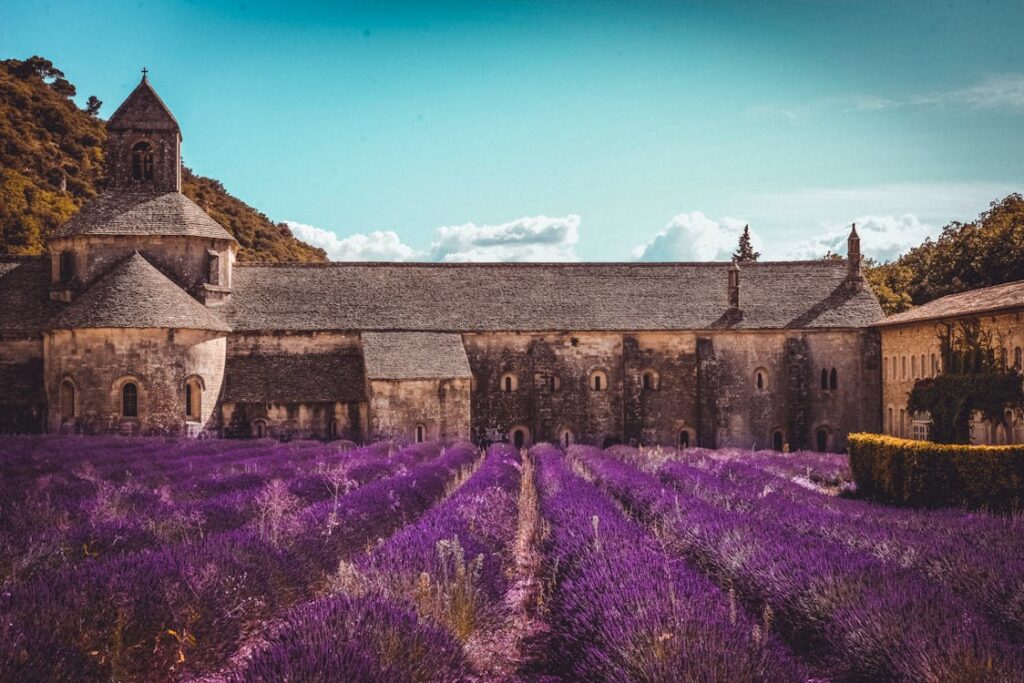
Provence, located in the southeastern part of France, is a region renowned for its captivating blend of ancient history and natural beauty. The area is dotted with remarkably well-preserved Roman ruins, such as the majestic Pont du Gard aqueduct, the ancient theater in Orange, and the impressive arena in Arles, each reflecting the region’s significance during the Roman Empire. Complementing its historical allure, Provence is famous for its vibrant lavender fields, which bloom in a stunning display of purple from late June to early August. These fragrant fields, set against the backdrop of quaint villages and rolling hills, create a picturesque landscape that attracts photographers, artists, and travelers worldwide. The unique combination of Roman heritage and natural splendor makes Provence a must-visit destination for those seeking to experience southern France’s rich cultural tapestry and scenic charm.
Pont du Gard
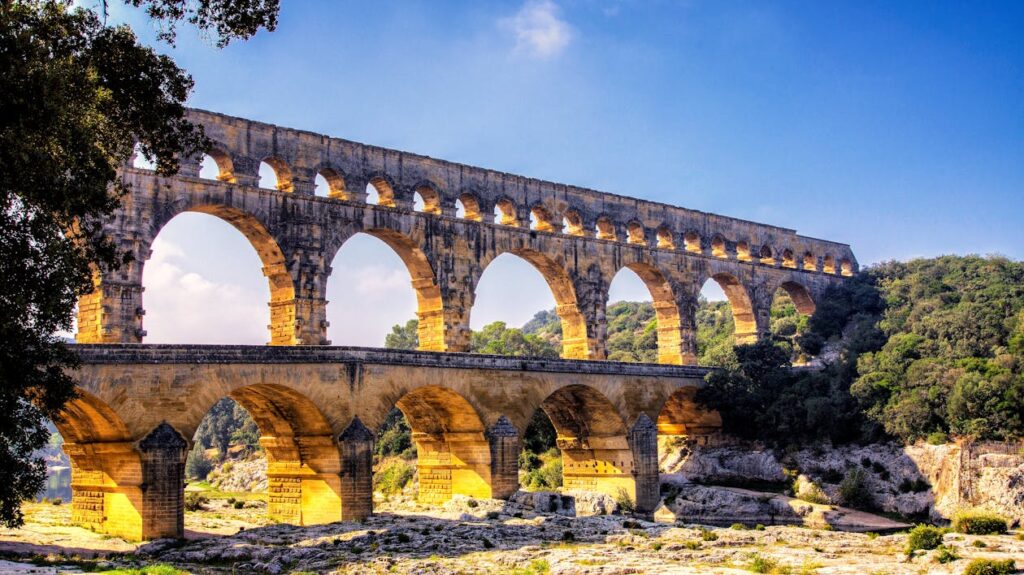
The Pont du Gard is an ancient Roman aqueduct bridge located in the South of France, near Vers-Pont-du-Gard. Standing as a testament to Roman engineering prowess, it was built in the first century AD to carry water over the Gardon River to the Roman colony of Nemausus, now modern-day Nîmes. This impressive structure, made up of three tiers of arches, stretches 275 meters (902 feet) long and rises to a height of 48 meters (157 feet), making it one of the tallest Roman aqueducts still in existence. The Pont du Gard is an architectural marvel and a UNESCO World Heritage site, drawing visitors from around the world to marvel at its grandeur and historical significance.
Roman Aqueduct History
Roman aqueducts were vital to the cities of the Roman Empire, providing a continuous supply of fresh water for public baths, fountains, households, and irrigation. The Pont du Gard is a prime example of Roman ingenuity, constructed without mortar and using precisely cut stones that fit together seamlessly. Built during the reign of Emperor Claudius, it formed part of a 50-kilometer (31-mile) aqueduct system that transported water from the Eure Spring to Nemausus. This network of aqueducts showcases the Romans’ advanced understanding of hydraulics and engineering. The longevity and preservation of the Pont du Gard highlight the quality of Roman construction techniques and their ability to create infrastructure that could endure for millennia.
Guided Tours and Nearby Attractions
Visiting the Pont du Gard offers a rich, immersive experience through guided tours that delve into the history and engineering behind this ancient aqueduct. These tours provide detailed explanations of its construction, function, and the daily life of the Romans who relied on its waters. In addition to exploring the aqueduct, visitors can enjoy the museum on-site, which offers interactive exhibits about Roman engineering and the region’s history. The surrounding area boasts a variety of attractions, including the picturesque medieval town of Uzès, with its charming streets and historical buildings, and the city of Nîmes, known for its remarkably preserved Roman architecture like the Arena of Nîmes and the Maison Carrée. Outdoor enthusiasts can also hike or kayak along the Gardon River, taking in the region’s natural beauty and historical context.
Lavender Fields

The lavender fields of Provence are a captivating and iconic feature of the region, transforming the landscape into a sea of vibrant purple during the blooming season. Stretching across vast expanses of rolling hills and picturesque countryside, these fields are particularly prominent in the Plateau de Valensole, the Luberon, and the Sault Plateau. The sight of endless rows of lavender in full bloom, set against the backdrop of charming villages and ancient stone farmhouses, creates a breathtakingly serene and aromatic experience. The lavender fields contribute to the region’s natural beauty and support its local economy through tourism and the production of lavender-based products.
Historical Significance of Lavender Cultivation
Lavender has been cultivated in Provence for centuries, with its uses and significance deeply rooted in the region’s cultural and economic history. Initially valued for its medicinal properties and use in perfumery, lavender became an essential crop for the local economy. During the Middle Ages, it was used for its antiseptic and healing properties, while in the Renaissance, its fragrance made it a popular ingredient in perfumes and cosmetics. The cultivation of lavender expanded significantly in the 19th century, driven by the demand from the burgeoning perfume industry in nearby Grasse, the world’s perfume capital. Lavender cultivation has since become a symbol of Provence, representing its agricultural heritage and traditional craftsmanship.
Tours and Seasonal Visits
Visiting the lavender fields of Provence is a seasonal delight, with the best time to experience the fields in full bloom, typically from late June to early August. Guided tours offer an in-depth exploration of the lavender-growing regions, providing insights into the cultivation and harvesting processes. These tours often include visits to local distilleries, where visitors can learn about the production of lavender essential oil and other products. Popular tour destinations include the Valensole Plateau, known for its extensive and photogenic lavender fields, and the Sénanque Abbey, where monks have cultivated lavender for centuries. Festivals like the Lavender Festival in Sault celebrate the harvest with music, markets, and traditional Provençal crafts. Whether through guided tours or self-guided explorations, visiting Provence’s lavender fields offers a unique and aromatic journey into the heart of one of France’s most beloved regions.
Conclusion
Recap of the Historical Sites Covered
- Palace of Versailles: Symbol of French monarchy and Baroque architecture.
- Louvre Museum: Home to iconic artworks and historical artifacts.
- D-Day Beaches: Landmarks of World War II and Allied liberation.
- Pont du Gard: Roman aqueduct showcasing ancient engineering.
- Provence Lavender Fields: Natural beauty and cultural heritage.
- Bordeaux Wine Region: Famous for its vineyards and historical architecture.
Importance of Historical Tourism in Preserving French Heritage
- Promoting Awareness: Educating visitors about French history and culture.
- Conservation Efforts: Supporting maintenance and restoration of sites.
- Cultural Appreciation: Preserving and celebrating national identity.
- Economic Impact: Supporting local communities and businesses.
Final Thoughts on Exploring France’s Rich History
Exploring France’s rich history offers a profound journey through some of the world’s most iconic historical sites. Each site, from the grandeur of Versailles to the natural beauty of Provence’s lavender fields, contributes to a deeper understanding of French culture, art, and history. Historical tourism allows visitors to connect with the past and plays a crucial role in preserving and promoting French heritage for future generations. By exploring these sites, we enrich our understanding of human achievement and the enduring legacy of the past. France’s historical sites are not merely places to visit; they are windows into the soul of a nation, offering insights into its cultural richness and historical significance.
